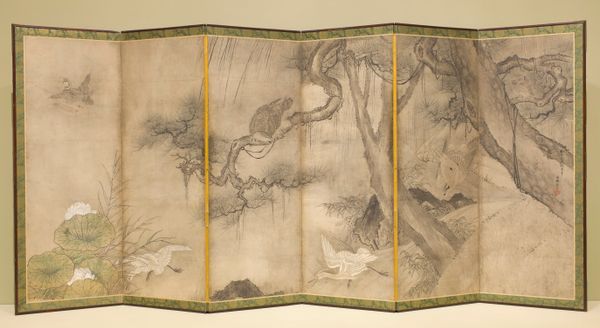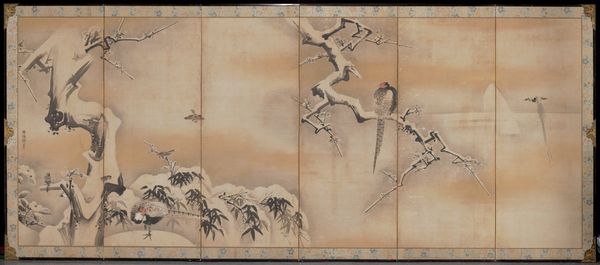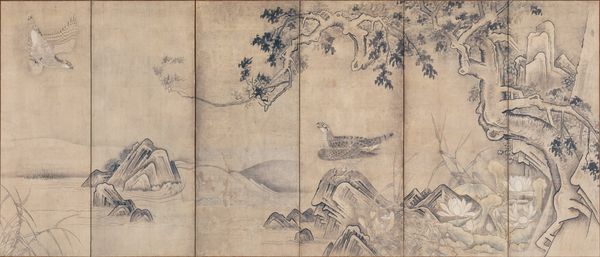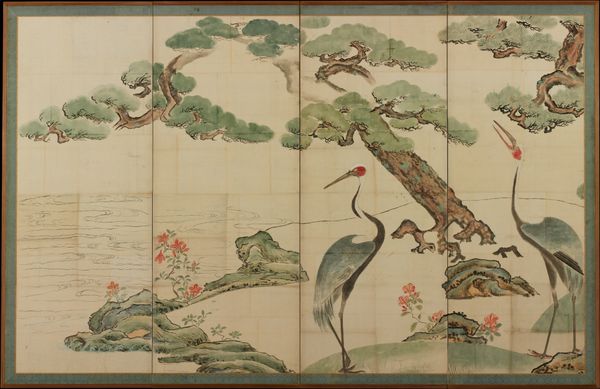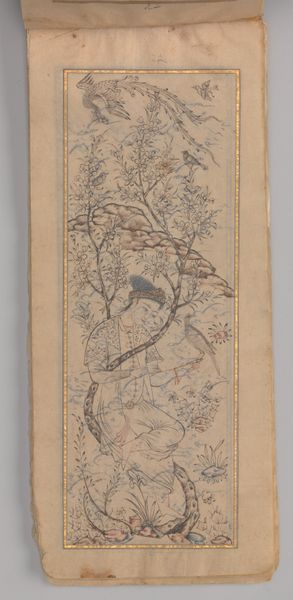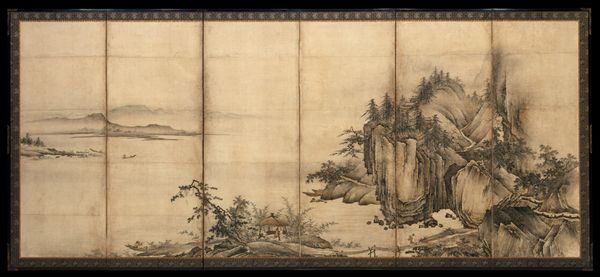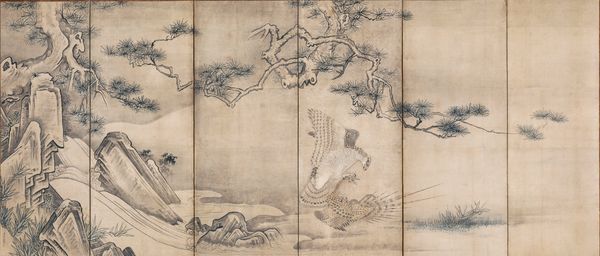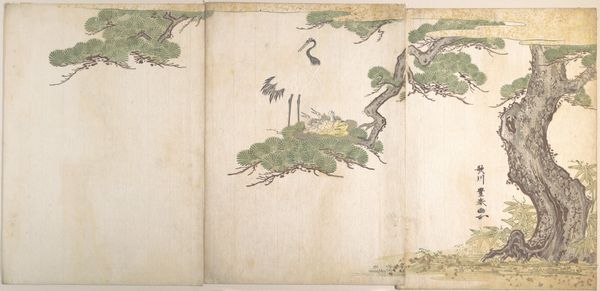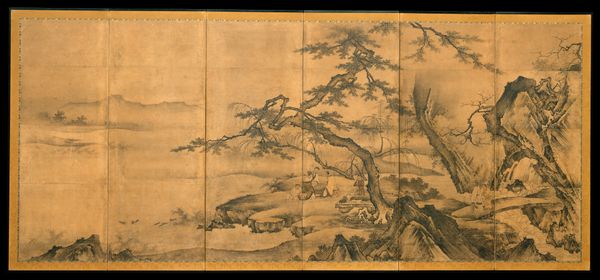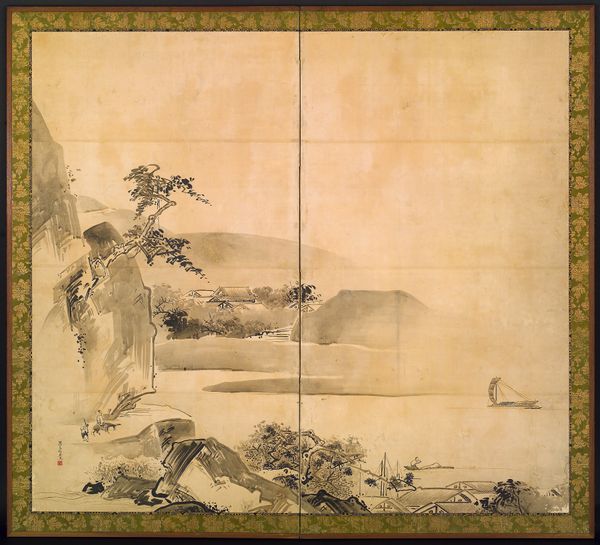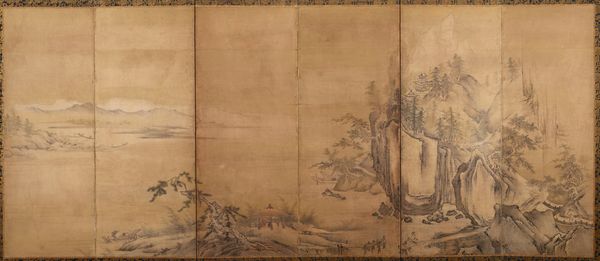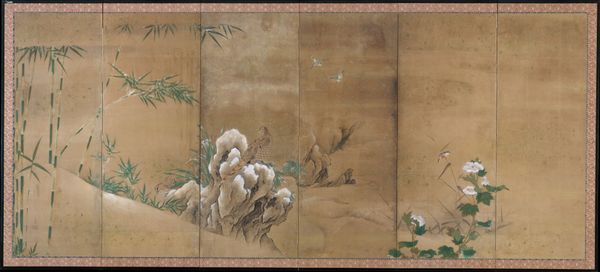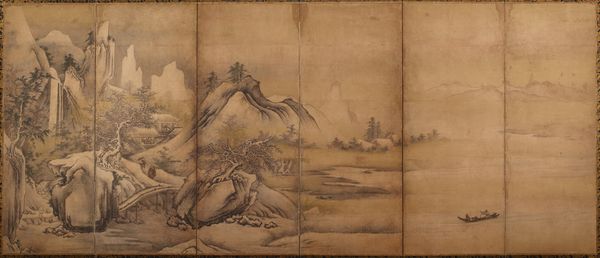![Birds in Landscape [left of a pair] by Shūgetsu Tōkan](/_next/image?url=https%3A%2F%2Fd2w8kbdekdi1gv.cloudfront.net%2FeyJidWNrZXQiOiAiYXJ0ZXJhLWltYWdlcy1idWNrZXQiLCAia2V5IjogImFydHdvcmtzLzIyNzNjMzRmLTc3YTctNDEzOS1iZDlmLWM2OWIyNjZjN2M0Mi8yMjczYzM0Zi03N2E3LTQxMzktYmQ5Zi1jNjliMjY2YzdjNDJfZnVsbC5qcGciLCAiZWRpdHMiOiB7InJlc2l6ZSI6IHsid2lkdGgiOiAxOTIwLCAiaGVpZ2h0IjogMTkyMCwgImZpdCI6ICJpbnNpZGUifX19&w=3840&q=75)
Birds in Landscape [left of a pair] c. early 16th century
0:00
0:00
Dimensions: 60 1/2 × 141 1/2 in. (153.67 × 359.41 cm) (image)65 7/8 × 146 1/2 × 3/4 in. (167.32 × 372.11 × 1.91 cm) (mount)
Copyright: Public Domain
Curator: Let’s take a look at this gorgeous folding screen attributed to Shūgetsu Tōkan, made around the early 16th century. It's ink on paper, titled "Birds in Landscape." Editor: It feels surprisingly minimalist for something so detailed. I’m struck by how delicate the linework is, almost like threads pulled across the paper. What paper was commonly used in that period? Curator: Well, remember that these screens, beyond being aesthetic objects, were quite functional in domestic spaces, dividing rooms and affecting traffic flow. The paper, likely a durable but lightweight variety, played a crucial role in its mobility. Editor: True, you have to consider the weight, especially for such a large piece. The scale is compelling. Looking closely, I see a lot of texture created by the layering of ink washes. Did they build the landscape up through multiple applications? Curator: Precisely. Consider the socio-political context: Muromachi period Japan was marked by Zen Buddhism’s influence, which prioritized simplicity, mindfulness, and a deep connection with nature. Artists of the time sought to reflect this through technique and composition. Editor: It's more than a picture then; the process embodies values, revealing labor invested in creating it, in preparing the ink, sizing the paper. The materials aren’t just neutral. The types of inks were available and dictated a kind of restrained palette too. Curator: Indeed, the seemingly simple monochrome palette of the painting also has connections to the Chan aesthetic ideals of that era. As we observe the careful placement of each bird and branch, and even how negative space is handled. It represents the court. Editor: Yes! And how was artwork displayed? For the elites? If it wasn't just the object but also the act of viewership itself, right, and what does that consumption, how that connects back to the work and production again. Curator: That's right, so it brings a different context to that space, it transforms the surrounding. That itself transforms how one moves through a space. The birds become part of it. Editor: Well, now I appreciate that minimalism as not just an aesthetic choice, but as an essential element of the work’s functionality and message. The simplicity helps us slow down and consider the whole ecosystem represented, beyond the beautiful execution.
Comments
minneapolisinstituteofart almost 2 years ago
⋮
This pair of screens show a variety of birds among trees and flowers, a popular painting subject in the 1500s. At right, a horned owl in the far upper corner watches a boisterous scene below from his perch in the branches of a pine tree: a pair of hawks have zeroed in on a pair of white herons who run for cover toward lotuses and reeds. The left screen also features pairs of birds, including geese, cranes, and crested mynas among bamboo and a plum tree. Although the screens are not signed by the artist, the later painter Kano Yasunobu (1614–1685) wrote inscriptions on the outside edge of each screen assigning them to Shūgetsu Tōkan, a Zen priest and painter active 100 years earlier.
Join the conversation
Join millions of artists and users on Artera today and experience the ultimate creative platform.
